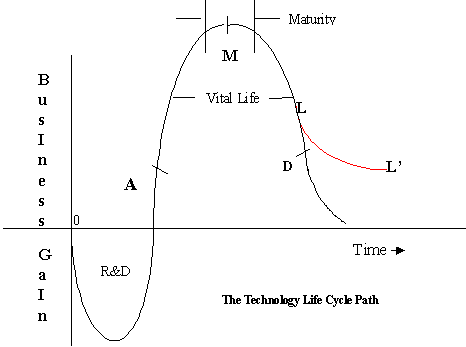
In economics, Kondratiev waves are hypothesized cycle-like phenomena in the modern world economy. The phenomenon is closely connected with the technology life cycle.

Innovation is the practical implementation of ideas that result in the introduction of new goods or services or improvement in offering goods or services. ISO TC 279 in the standard ISO 56000:2020 defines innovation as "a new or changed entity, realizing or redistributing value". Others have different definitions; a common element in the definitions is a focus on newness, improvement, and spread of ideas or technologies.
In business and engineering, product development or new product development covers the complete process of bringing a new product to market, renewing an existing product and introducing a product in a new market. A central aspect of NPD is product design, along with various business considerations. New product development is described broadly as the transformation of a market opportunity into a product available for sale. The products developed by an organisation provide the means for it to generate income. For many technology-intensive firms their approach is based on exploiting technological innovation in a rapidly changing market.
In economics, internationalization or internationalisation is the process of increasing involvement of enterprises in international markets, although there is no agreed definition of internationalization. Internationalization is a crucial strategy not only for companies that seek horizontal integration globally but also for countries that addresses the sustainability of its development in different manufacturing as well as service sectors especially in higher education which is a very important context that needs internationalization to bridge the gap between different cultures and countries. There are several internationalization theories which try to explain why there are international activities.

Research and development is the set of innovative activities undertaken by corporations or governments in developing new services or products, and improving existing ones. Research and development constitutes the first stage of development of a potential new service or the production process.

Diffusion of innovations is a theory that seeks to explain how, why, and at what rate new ideas and technology spread. The theory was popularized by Everett Rogers in his book Diffusion of Innovations, first published in 1962. Rogers argues that diffusion is the process by which an innovation is communicated thorough certain channels over time among the participants in a social system. The origins of the diffusion of innovations theory are varied and span multiple disciplines.
Leapfrogging is a concept used in many domains of the economics and business fields, and was originally developed in the area of industrial organization and economic growth. The main idea behind the concept of leapfrogging is that small and incremental innovations lead a dominant firm to stay ahead. However, sometimes, radical innovations will permit new firms to leapfrog the ancient and dominant firm. The phenomenon can occur to firms but also to leadership of countries or cities, where a developing country can skip stages of the path taken by industrial nations, enabling them to catch up sooner, particularly in terms of economic growth.
Technological change (TC) or technological development is the overall process of invention, innovation and diffusion of technology or processes. In essence, technological change covers the invention of technologies and their commercialization or release as open source via research and development, the continual improvement of technologies, and the diffusion of technologies throughout industry or society. In short, technological change is based on both better and more technology.

The Gartner hype cycle is a graphical presentation developed, used and branded by the American research, advisory and information technology firm Gartner to represent the maturity, adoption, and social application of specific technologies. The hype cycle claims to provide a graphical and conceptual presentation of the maturity of emerging technologies through five phases.
Product innovation is the creation and subsequent introduction of a goods or service that is either new, or an improved version of previous goods or services. This is broader than the normally accepted definition of innovation that includes the invention of new products which, in this context, are still considered innovative.
International business refers to the trade of Goods and service goods, services, technology, capital and/or knowledge across national borders and at a global or transnational scale.

The flying geese paradigm is a view of Japanese scholars regarding technological development in Southeast Asia which sees Japan as a leading power. It was developed in the 1930s, but gained wider popularity in the 1960s, after its author, Kaname Akamatsu, published his ideas in the Journal of Developing Economies.

The technology adoption lifecycle is a sociological model that describes the adoption or acceptance of a new product or innovation, according to the demographic and psychological characteristics of defined adopter groups. The process of adoption over time is typically illustrated as a classical normal distribution or "bell curve". The model indicates that the first group of people to use a new product is called "innovators", followed by "early adopters". Next come the early majority and late majority, and the last group to eventually adopt a product are called "Laggards" or "phobics." For example, a phobic may only use a cloud service when it is the only remaining method of performing a required task, but the phobic may not have an in-depth technical knowledge of how to use the service.
The Product Life Cycle Theory is an economic theory that was developed by Raymond Vernon in response to the failure of the Heckscher–Ohlin model to explain the observed pattern of international trade. The theory suggests that early in a product's life-cycle all the parts and labor associated with that product come from the area where it was invented. After the product becomes adopted and used in the world markets, production gradually moves away from the point of origin. In some situations, the product becomes an item that is imported by its original country of invention. A commonly used example of this is the invention, growth and production of the personal computer with respect to the United States.
Technology management is a set of management disciplines that allows organizations in managing their technological fundamentals to create customer advantage. Typical concepts used in technology management are:
The Linear Model of Innovation was an early model designed to understand the relationship of science and technology that begins with basic research that flows into applied research, development and diffusion
Technological transitions (TT) can best be described as a collection of theories regarding how technological innovations occur, the driving forces behind them, and how they are incorporated into society. TT draws on a number of fields, including history of science, technology studies, and evolutionary economics. Alongside the technological advancement, TT considers wider societal changes such as "user practices, regulation, industrial networks, infrastructure, and symbolic meaning or culture". Hughes refers to the 'seamless web' where physical artifacts, organizations, scientific communities, and social practices combine. A technological transition occurs when there is a major shift in these socio-technical configurations.
Smihula waves are long-term waves of technological progress which are reflected also in long-term economic waves. They are a crucial notion of Daniel Šmihula's theory of technological progress.
Product strategy defines the high-level plan for developing and marketing a product, how the product supports the business strategy and goals, and is brought to life through product roadmaps. A product strategy describes a vision of the future with this product, the ideal customer profile and market to serve, go-to-market and positioning (marketing), thematic areas of investment, and measures of success. A product strategy sets the direction for new product development. Companies utilize the product strategy in strategic planning and marketing to set the direction of the company's activities. The product strategy is composed of a variety of sequential processes in order for the vision to be effectively achieved. The strategy must be clear in terms of the target customer and market of the product in order to plan the roadmap needed to achieve strategic goals and give customers better value.

Technology readiness levels (TRLs) are a method for estimating the maturity of technologies during the acquisition phase of a program. TRLs enable consistent and uniform discussions of technical maturity across different types of technology. TRL is determined during a technology readiness assessment (TRA) that examines program concepts, technology requirements, and demonstrated technology capabilities. TRLs are based on a scale from 1 to 9 with 9 being the most mature technology.









